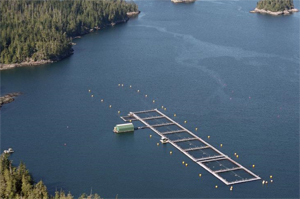Where will our seafood come from in the future?
There has been a truly amazing revolution going on in our lifetime. The past four decades have seen the birth and rapid growth of the world fish farming industry. Currently, almost half (47%) of seafood is produced by farming (also called aquaculture). If the industry continues to grow at its present rate (7.4%), it may provide 62% of the world’s protein by 2050.
This is not to say that the world’s wild-caught fisheries will not provide a significant share of seafood production. Although there have been some claims that our oceans’ fisheries production will collapse this century, I do not believe this will be the case.
Yes, there have been problems with collapses of major fisheries, but currently over half of the world fisheries are at sustainable levels. I think solutions will be found for some of the problem fisheries. However, it is true that we have at least reached maximum production and there will be level production or somewhat reduced production in the future.

Most farmed seafood originates in Asian countries. (Florida Sea Grant)
Where are the fish farms? Although you don’t see many fish farms in Florida, there is a successful clam farming industry here, mostly centered in the Cedar Key area. However, shrimp and fish farms have not been financially successful in Florida. There are major fish/shrimp farming industries in central and south America as well as in Europe. But as you can see from the adjoining graphic, Asia is the 800-lb gorilla of the aquaculture industry.
Why is that? There are a number of contributing explanations (government policies and subsidies, geography, etc.), but the one-word answer is economics. It is very difficult to compete with low-cost land and a seemingly endless supply of low-cost labor found in many Asian countries, especially China.
Are there any problems with fish farming? Yes. There are problems. Remember, this is essentially a new industry. At the beginning of this article I noted that modern fish farming started about 40 years ago. When shrimp farming started, mangrove wetlands where destroyed to create shrimp ponds. Fish farms in coastal waters, in some cases, led to too much waste being released into surrounding waters. Densely packed fish farms resulted in disease and parasites spreading through farmed fish. These fish often escaped, spreading disease to wild populations.

Salmon farm in British Columbia (BC Salmon Farmers Association)
However, as the industry matures, fish farmers and environmental regulators are learning from past mistakes. Innovative solutions are being developed that will help the industry progress in a more sustainable, environmentally compatible manner. Some farmers are beginning to raise seaweed and filter-feeding mollusks near fish farms to take up waste products. Improvements in animal husbandry and feed formulations are reducing disease.
Some innovative thinkers have come up with ideas to farm the open ocean where waste products would be rapidly dispersed by ocean currents. One idea is to have submerged fish pens equipped with large propellers that could ride in stable ocean currents and then return months later to their starting point.
No such thing as a free fish! The most difficult problem to solve in the future of fish farming is the fact that it takes fish protein to produce fish protein. The fish meal used to feed farmed fish contains a large amount of fish protein that comes from small wild fish such as anchovies and sardines. Hence, eventually overfishing problems could develop with these species. In years past, most fish meal was fed to pigs and chickens. Now fish farming consumes 68% of the fish meal currently being produced.

New design for submersible fish cage. (Ocean Farm Technologies)
However, advances are being made to develop better formulations that can reduce the amount of fish protein needed in the meal and more efficient feeding practices are being developed. Scientists are working on ways to make microscopic algae produce the omega-3 fatty acids that make seafood such a healthy food choice. Innovations like this may reduce the amount of fish that need to be harvested to produce fish meal, and increase the potential to increase farm fish production without depleted other fish stocks.
What will the future bring? The growth of the world fish farming industry has been phenomenal. Because of the health attributes of eating seafood, demand is increasing. We cannot count on increased production of wild-caught fisheries to meet this demand. Fish farming has and will continue to provide an increasing amount of the seafood we eat. However, the problems facing the industry I mentioned are very real. It will take quite a number of innovative and brilliant minds to develop solutions. Perhaps some the projections for the growth of modern fish farming industry may be overly optimistic, but it seems reasonable to conclude that it will provide an important source of protein to meet the world’s future needs.
Read more of The Marine Scene.



